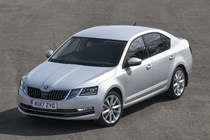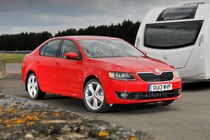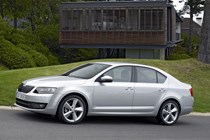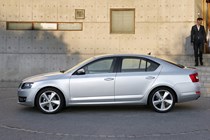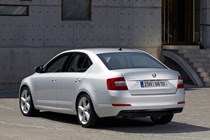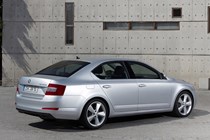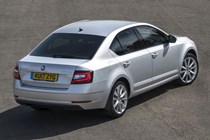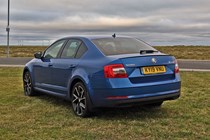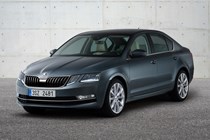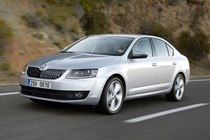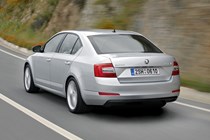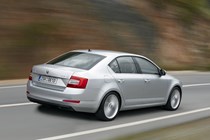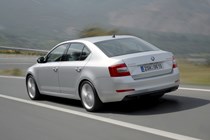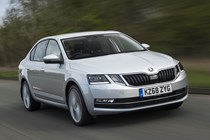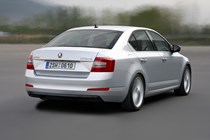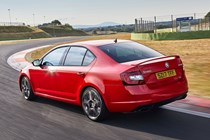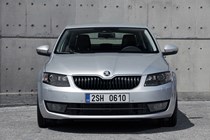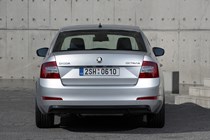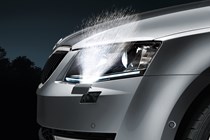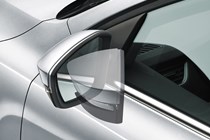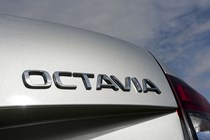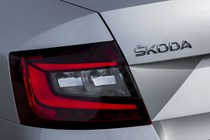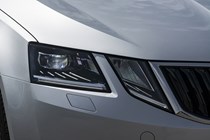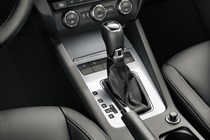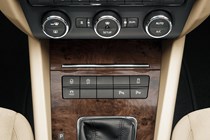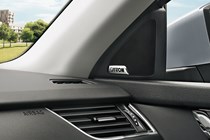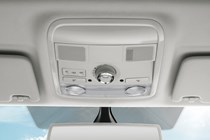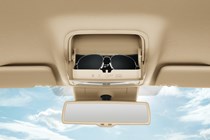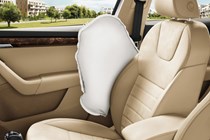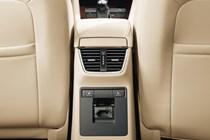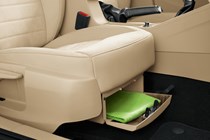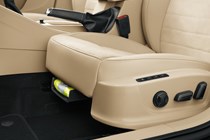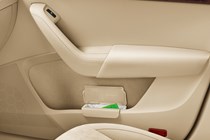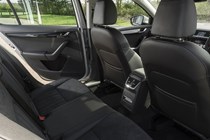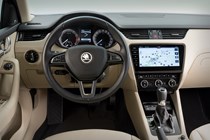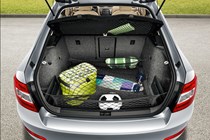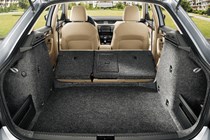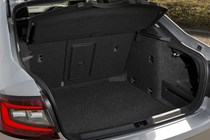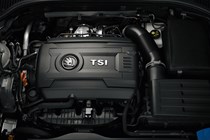
Skoda Octavia Hatchback (2013-2020) engines, drive and performance


- Frugal range of engines available
- Three-cylinder 1.0-litre petrol on offer
- High-performance vRS models add excitement
The standard Octavia’s engine range comprises of three petrol and two diesel engines, which are offered in a variety of power outputs. In addition to this, the sports-orientated vRS models also include a more powerful diesel and petrol option.
Strong and frugal diesels
The Octavia offers a choice of 1.6- or 2.0-litre TDI diesel engines. Both come with a six-speed manual as standard but a seven-speed DSG automatic gearbox is available.
As of the 2017 facelift, the 115hp 1.6-litre TDI replaces the old 110hp engine. It offers the same power as the 1.0-litre petrol, but produces far more torque – 250Nm over 200Nm. That means the 1.6-litre diesel feels noticeably stronger when accelerating in a high gear, and is better suited to motorway driving. It’s noisy on start-up, though, and remains so when accelerating from a standstill. Acceleration is rated at 10.2 seconds to 62mph, and 10.4 for the DSG version.
Move up to the 150hp 2.0-litre TDI and 0-62mph times are slashed to 8.5 seconds (8.9 for the DSG). It’s quieter around town than the 1.6-litre and provides more pulling power at higher speeds, however there’s little to entice enthusiastic drivers.
Punchy petrols
As of May 2016, the mainstream Octavia petrol engines come in 1.0-litre TSI and 1.5-litre TSI EVO guises. The former replaces the old 110hp 1.2-litre unit, while the latter is an upgraded version of the previous 140hp 1.4. An optional seven-speed DSG automatic is available on all engines, as well as the standard six-speed manual.
The base 115hp 1.0-litre TSI is borrowed from within the Volkswagen Group, also featuring in the Golf and Leon sister cars. Given the size of the Octavia – with capacious boot and plenty of room for front and rear occupants – you could be forgiven for skipping past this and looking to the 1.5-litre or diesel models traditionally associated with effortless motorway cruising.
There’s a clue, though, as to how effective this powertrain is in the spec sheet. With 0-62mph taking 10.0 seconds and a top speed of 124mph, this small engine combines sensible motorway gearing and pace. Performance hatches won’t have anything to worry about, but it’s more than sufficient for British roads and traffic.
Throw in a combined WLTP economy figure up to 48mpg, and the dominance of diesel looks decidedly dated. To put it to the test, we took the SE Drive on a 536 mile round trip to Scotland from the midlands, in a day.
Urban traffic and motorways don’t really show the Octavia’s advantage. It will potter around town with a subdued growl away from the lights and not much wind, road or engine noise otherwise, with soft, sensible suspension absorbing speed bumps, repaired patches and changes in road surface effectively.
Top gear motorway cruising is also very respectable with the engine spinning below 2,500rpm – better yet, there’s enough grunt to stay in sixth on inclines.
Those looking for more power also have the option of a 150hp 1.5-litre TSI EVO engine. It’s noticeably quicker than the 1.0-litre – accelerating from 0-62mph in 8.3 seconds (the DSG takes the same time) – and pulls up hills with far more gusto.
It sounds harsh when revved however, and there’s little character to entertain keen drivers. But with fuel shut-off technology and stop-start, it’s also considerably more economical than the 1.4-litre model it replaces.
A powerful 190hp 2.0-litre TSI is available in models such as the higher-spec SE L and Laurin & Klement. It’s only offered with a DSG but, in part thanks to this, it’s capable of delivering a 0-62mph time of just 7.3sec.
Performance vRS models
For the most performance available, Skoda also offers diesel and petrol vRS variants of the Octavia. All-wheel drive is available on both, as is a seven-speed DSG.
The diesel version is fitted with a 2.0-litre TDI, which produces 184hp and is shared with some other models in the Octavia range. It’s enough for a 0-62mph time of 8.1 seconds in the front-wheel drive model and 7.6 seconds in 4x4 DSG spec (all-wheel drive is only available with DSG).
The front-wheel drive only petrol is powered by a 245hp 2.0-litre TSI engine, and accelerates from 0-62mph in 6.6 seconds in DSG or six-speed manual form. This version replaced the previous 230hp vRS.

Octavia vRS 245
Using a revised version of the 2.0-litre TSI petrol found in the regular vRS, this sportier model comes with the option of a six-speed manual (standard-fit) or an optional seven-speed twin-clutch DSG automatic gearbox.
Both have exactly the same performance figures, so which one you choose will depend heavily on the sort of driving you do and which you prefer to use – in reality though the automatic feels quicker thanks to its super smooth and fast gear shifts.
The manual option is exactly the same as in the regular vRS, but the automatic transmission features an extra gear. This doesn’t make it any worse to drive, however – the correct gear is always available if left to its own devices.
While the second setting does make the ‘box keener to drop down a gear or two for fast acceleration, it also shifts back up quickly afterwards. We’ve found other VW Group cars like the Golf GTI or SEAT Leon Cupra tend to hold on to low gears noisily for longer than necessary. This makes the Octavia an altogether more relaxing, but no less potent hot hatch.
You’re also able to change gears using the slightly diminutive paddles mounted on the back of the steering wheel if you require greater control. These are plasticky and make a bit of an uninspiring clack though.
The other key difference, apart from the 15hp power hike to 245hp (which drops the 0-62mph time down to 6.6 seconds), is a new exhaust system that sounds much more purposeful, without being too loud. It’s a likeable, addictive noise that we’d suggest any keen driver will appreciate.
Handling
- Predictable and stable drive lacks excitement
- Compliant suspension manages UK roads nicely
- Performance vRS model adds some spice
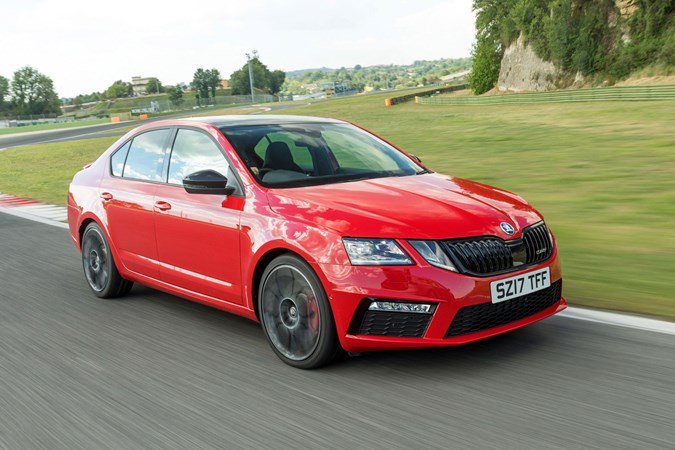
It’s quite clear that the handling of regular Octavias prioritises safety and stability. The Skoda is neither as poised nor as agile through corners as a VW Golf, SEAT Leon or Ford Focus, but there’s a strong sense of security, even at higher speeds.
Turn into a sharp bend and, because of the softer, comfort-orientated suspension there’s a fair amount of lean from the body of the car. Even so, grip levels are impressively high and allow the driver to carry plenty of speed through the corner.
The steering set-up also contributes to the relaxed but stable nature of the handling, remaining consistent and neutral at all speeds.
Adaptive suspension available for the Octavia
Should customers wish, they can also spec Dynamic Chassis Control (DCC) from SE models upwards, allowing the driver to tweak the suspension settings between Comfort, Normal and Sport modes. It’s the same system as that seen on other Volkswagen Group products (such as the Audi A3) and, along with drive modes that are standard on SE grade and above, it helps tailor the driving experience.
Despite its levels of practicality, the Octavia is also surprisingly easy to park – although we’d still recommended the acoustic rear sensors standard on SE and above.
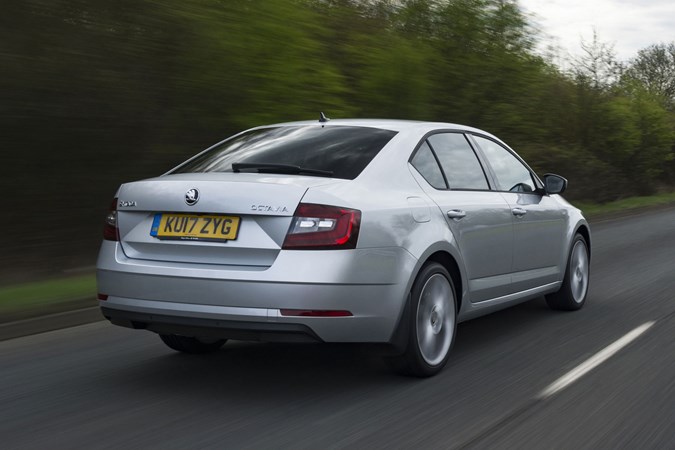
Octavia vRS models handle in a similar vein, yet with a dash of added excitement thanks to the extra power and revised sports suspension. Once again, it’s not the most involving to drive – you’re not blessed with tons of feedback through the steering wheel – but as a high-performance family car to drive everyday it excels.
The keen driver’s choice: Skoda Octavia vRS 245
Equipped with uprated brakes and an electrically controlled differential on the front axle, the best Octavia to drive quickly is the vRS 245. While the former upgrade helps slowing the car down, the latter measures out torque accurately to either front wheel to ensure no wheelspin on the exit of corners.
It simply bites and pulls the Octavia out or a bend in almost any situation, and certainly you’ll have to be travelling far quicker than is reasonable on the road to challenge this car’s traction levels.
We were impressed with how the 245 differs from the lower-powered vRS – so much so that if you like driving fast, this is the model to buy.
Given the size of the Octavia – with capacious boot and plenty of room for front and rear occupants – you could be forgiven for skipping past this and looking to the 1.5-litre or diesel models traditionally associated with effortless motorway cruising.
There’s a clue, though, as to how effective this powertrain is in the spec sheet. With 0-62mph taking 10.0 seconds and a top speed of 124mph, this small engine combines sensible motorway gearing and pace. Performance hatches won’t have anything to worry about, but it’s more than sufficient for British roads and traffic.
Throw in a combined WLTP economy figure up to 48mpg, and the dominance of diesel looks decidedly dated. To put it to the test, we took the SE Drive on a 536 mile round trip to Scotland from the midlands, in a day.
Urban traffic and motorways don’t really show the Octavia’s advantage. It will potter around town with a subdued growl away from the lights and not much wind, road or engine noise otherwise, with soft, sensible suspension absorbing speed bumps, repaired patches and changes in road surface effectively.
Top gear motorway cruising is also very respectable with the engine spinning below 2,500rpm – better yet, there’s enough grunt to stay in sixth on inclines.


